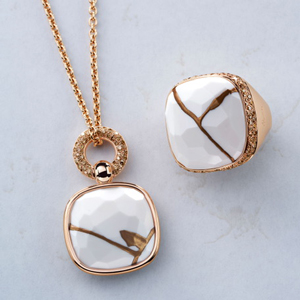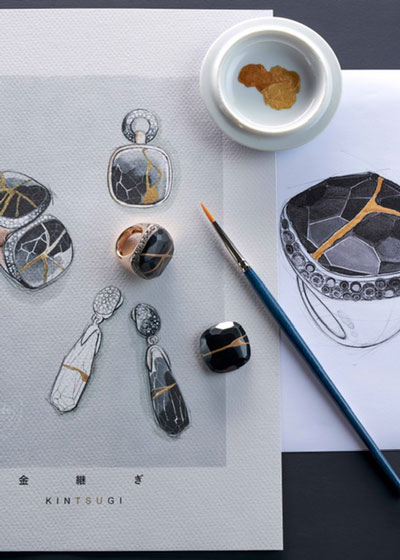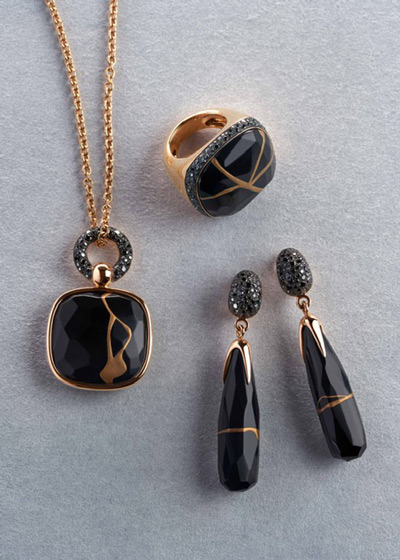
Profoundly broken things can be made whole again, and even improved upon.
That’s the idea behind Italian jeweler Pomellato’s collection for 2021’s Paris Haute Couture Week (which is digital this season, scheduled for Jan. 25–28). The Milanese jeweler’s capsule collection uses damaged gemstones to showcase a traditional Japanese mending technique called kintsugi: kin meaning “gold” and tsugi meaning “to join.”
First seen in the 15th century, the craft is an expression of the Japanese philosophy of resilience through a repair process that turns something damaged—usually pottery, but it can be anything—into something precious.
Lacquer masters practice the ancient art, and their expertise lies in reassembling the many components of a fractured item before the fast-drying lacquer bonds forever. Once the adhesive paste is applied to an item, it is left to dry for several weeks. Then the glue is sanded down to lie flush with the surface. At this point, a master craftsman beautifies the now-smooth seams by applying gold, silver, or platinum to them.
Pomellato’s couture collection is the result of a collaboration with a female master kintsugi artist based in Tokyo. The series is composed of two earrings, two rings, and two pendants, all of which feature artfully repaired black jet and kogolong (a white variant of opal). Craftspeople at the Casa Pomellato workshop set the stones into minimalist designs that showcase the bold kintsugi-made gold lines.
“We were very respectful of the centuries-old wisdom of the craft, and the aim is not to create perfection but a very individual and spontaneous result,” explained Pomellato creative director Vincenzo Castaldo in a prepared statement. “Each jewel is truly one-of-a-kind and this to me is the real essence of preciousness.”



There’s a legend tied to kintsugi’s beginnings: Shogun Ashikaga Yoshimasa (who reigned from 1449 to 1473) allegedly sent his favorite teabowl to China to be repaired. Disappointed with the clumsy look of the metal staples used to fix the fractured bowl, he is said to have challenged his craftsmen to find a better solution. They eventually restored the vessel using resin and powdered gold, introducing kintsugi to the world.
“I traveled to Japan in 2019 and while I was in Tokyo, I deepened my knowledge of the art of kintsugi,” Castaldo said in the statement. “I was drawn to the elegance of Japanese thinking and the idea of something broken becoming more precious through this ritual of repairing. The idea of celebrating your scars as a sign of strength through healing is a very contemporary philosophy.”
The idea of repurposing materials instead of discarding them also struck a chord with the executive. “I was inspired to find a way to bring kintsugi to Pomellato,” he added. “Milan and Tokyo may be many miles apart, but we share a poetic and uncommon vision of beauty over an artificially perfect ideal, and we both embrace diversity and imperfection in similar ways.”
Top: The kogolong kintsugi pieces in Pomellato’s new capsule collection (all photos courtesy of Pomellato)
Follow Emili Vesilind on Instagram: @emilivesilind
- Subscribe to the JCK News Daily
- Subscribe to the JCK Special Report
- Follow JCK on Instagram: @jckmagazine
- Follow JCK on X: @jckmagazine
- Follow JCK on Facebook: @jckmagazine